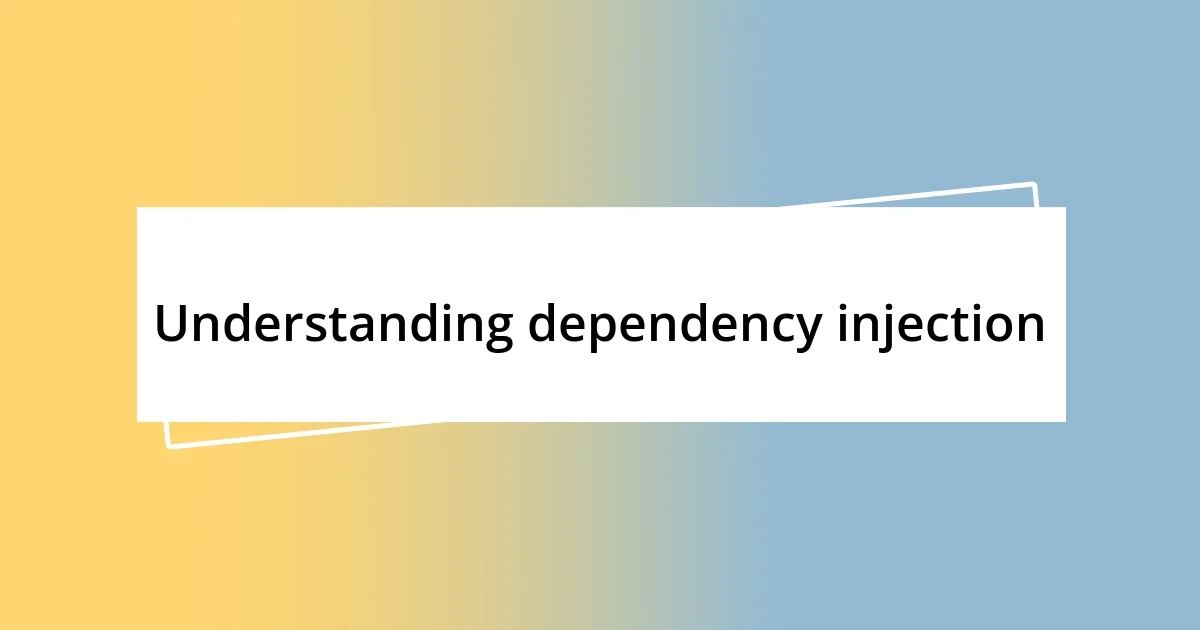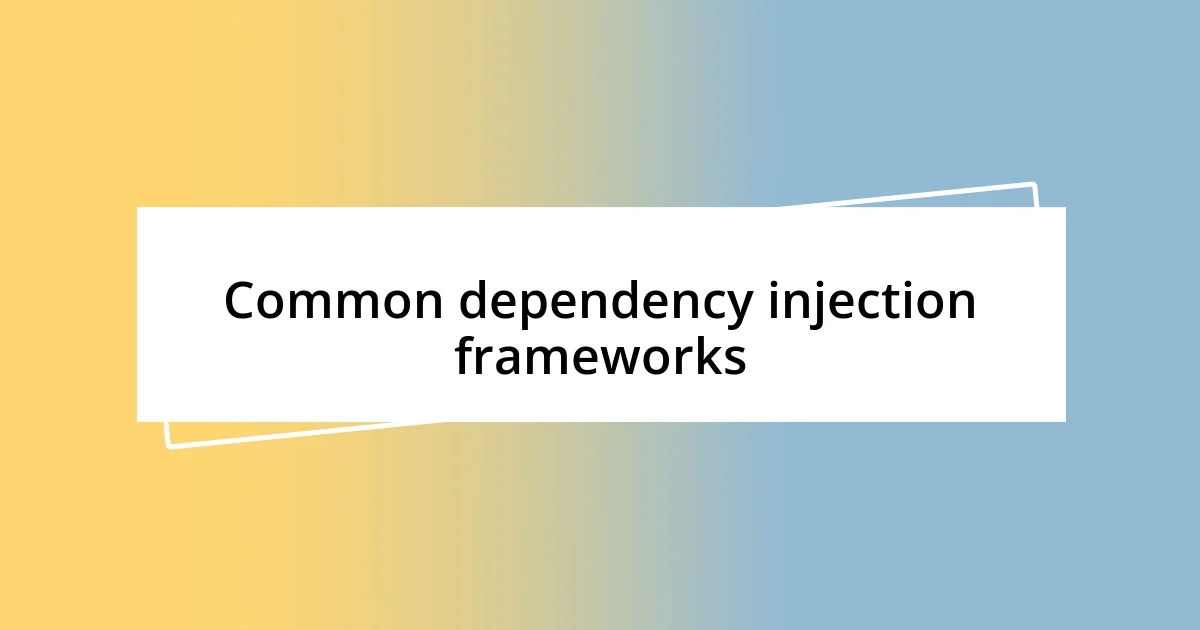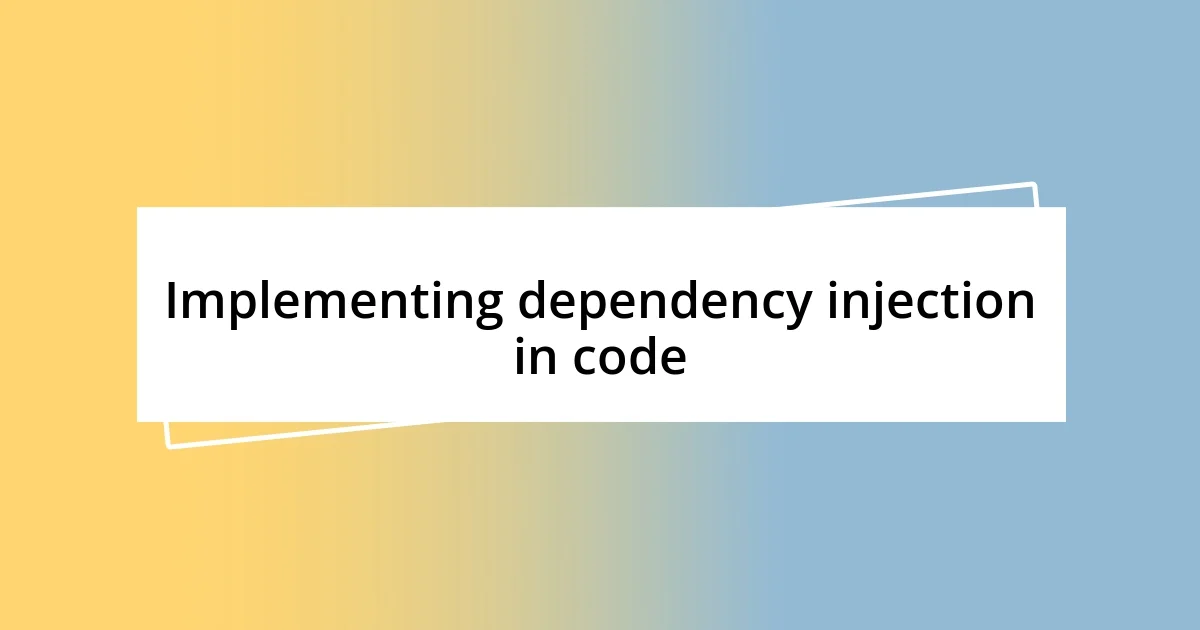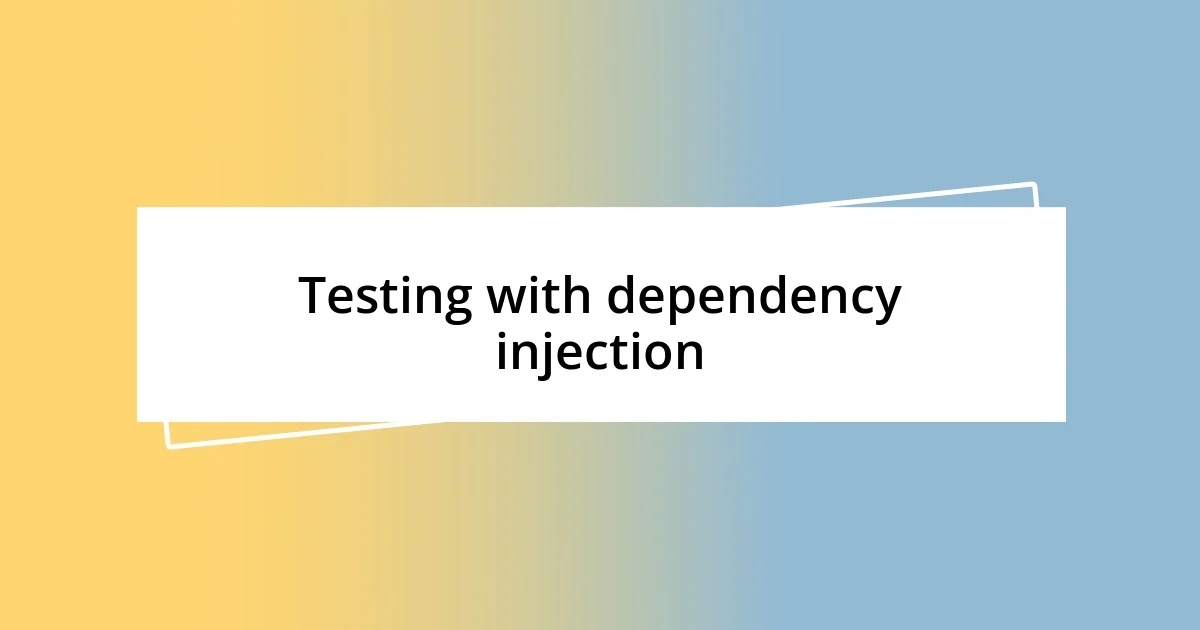Key takeaways:
- Dependency injection (DI) enhances code modularity and testability by managing class dependencies externally, simplifying debugging and maintenance.
- Using DI frameworks like Spring, Dagger, and Guice improves performance, reduces boilerplate code, and offers clear dependency management, facilitating easier integration and testing.
- Best practices for DI include adhering to the Single Responsibility Principle, using interface-based programming for flexibility, and effectively managing the lifecycle of dependencies to avoid overengineering and performance issues.

Understanding dependency injection
Dependency injection (DI) is a design pattern that allows developers to improve code modularity and testability. I remember when I first encountered it during a project; it clicked for me as a way to manage dependencies between classes without tightly coupling them. Isn’t it fascinating how a simple change in how we connect components can lead to more maintainable code?
At its core, DI addresses the complexity of managing dependencies by “injecting” them from the outside rather than having a class create its own dependencies. This made me reflect on my past experiences where manual instantiation was a nightmare during testing. Can you imagine trying to debug a tangled web of classes all instantiating each other? DI really clarified that for me.
Using dependency injection frameworks, such as Spring or Dagger, can streamline this process even further. I recall the relief I felt when I no longer had to worry about the creation and lifecycle of my components manually. With DI, I could focus on the actual business logic, which felt liberating. Have you ever felt that weight lifted when you streamlined a development process? It’s those small victories that keep us motivated!

Benefits of using dependency injection
One of the standout benefits of using dependency injection is enhanced testability. I clearly remember working on a project where mocking dependencies was a headache. With DI, I could simply swap out real components for mocks or stubs during testing. This means I could isolate the unit I was testing without worrying about the behavior of its dependencies. It felt like finally having a tool that empowered me to test my code efficiently.
- Improved Code Readability: By separating concerns, the overall structure becomes clearer.
- Easier Maintenance: Changes in one part of the system often require fewer adjustments elsewhere, saving time and effort.
- Increased Flexibility: You can swap implementations without changing much of the code, which I found invaluable during projects with shifting requirements.
- Better Adherence to SOLID Principles: DI naturally aligns with the Single Responsibility Principle and Dependency Inversion Principle, promoting better design practices.
In another instance, adopting DI led to a much simpler way of managing configurations. For a recent application, my team was juggling several third-party services. Initially, it felt overwhelming, but once we implemented DI, configuring and testing different services became a breeze. It was like finding the right key to unlock a door I had been staring at for ages. I could clearly define which services went where without a convoluted setup. What a relief that was!

Common dependency injection frameworks
When it comes to dependency injection frameworks, I find a few stand out due to their unique features and widespread use. Frameworks like Spring, for instance, are truly robust, mainly because they provide comprehensive support for various architectures. I still remember diving into Spring’s configuration after using traditional methods, and the enhancement in how my code behaved felt almost magical. It made me appreciate how out-of-the-box solutions can drastically reduce boilerplate code.
Then there’s Dagger, particularly popular in Android development. Unlike many frameworks that rely on reflection, Dagger uses compile-time validation for dependencies. This is where I felt a significant boost in performance and error detection. The day I transitioned to Dagger in one of my apps, the reduction in runtime errors was palpable, and I couldn’t help but smile knowing my code was leaner and more manageable. It felt liberating not to wade through errors during runtime anymore.
Lastly, there’s Guice, which I initially approached with skepticism but grew to admire. Guice’s simplicity captured my attention – its minimalist design allows for better integrations when you’re working in Java. In a recent project where I had to integrate different modules, using Guice felt like navigating a well-mapped road, helping me clearly understand where each dependency lay while reducing potential potholes or conflicts. Isn’t it interesting how the right tool can simplify a complex task?
| Framework | Key Features |
|---|---|
| Spring | Comprehensive, supports multiple architectures, and reduces boilerplate code. |
| Dagger | Compile-time validation for dependencies, efficient for Android applications. |
| Guice | Minimalist design, easy integration, and a clear structure for dependencies. |

Implementing dependency injection in code
Implementing dependency injection in code can be transformative, especially when you start using annotations. I recall one project where switching to annotations for dependency injection made my life so much easier. Instantly, I could see how the relationships between components were being defined, and it felt like everything clicked into place. Why struggle with lengthy configuration files when a simple annotation could do the job?
I often turn to constructor injection for its clarity. I remember a project where I had several layers of services, and constructor injection allowed me to pass dependencies directly into each layer. This not only eliminated ambiguity but also made it crystal clear which dependencies were essential for each component. Can you imagine the relief of not constantly checking which services needed to be initialized?
In practice, I’ve observed that using a service locator can introduce unnecessary complexity, even though it seems appealing at first. When I initially tried implementing it, I found that over time, tracking dependencies became a hassle. A colleague once remarked, “Isn’t service location just like hiding your dependencies under the rug?” And honestly, that’s how it felt—only after making the switch back to pure dependency injection did I realize how much clarity I’d been missing. It reinforced the notion that transparency in your code is crucial for long-term maintainability.

Testing with dependency injection
When it comes to testing with dependency injection, I’ve found it to be a game-changer. I remember working on a project where isolating components for unit testing became a breeze. By injecting mock dependencies, I could simulate various scenarios and focus on testing specific functionalities without worrying about side effects from other parts of the system. Isn’t it fascinating how a simple design pattern can make testing feel less daunting?
One notable experience I had was when I introduced a mocking framework to facilitate my tests. Initially, I hesitated, thinking it might complicate the process. However, once I embraced the power of injecting mocks, the test coverage improved remarkably. It felt rewarding to see how easily I could simulate different return values and behavior for dependencies. I still chuckle thinking about how I ended up spending much more time writing tests than I ever had before, all because I could finally ensure that each part of my code worked flawlessly in isolation.
Additionally, I’ve learned that writing tests with dependency injection often leads to clearer, more maintainable code. In a recent endeavor, I noticed that as I refactored my code to use dependency injection more consistently, the tests themselves became easier to read and understand. Have you ever experienced that moment when you look back at your own tests and feel a sense of pride in their clarity? It’s a true sign of progress, and I believe that embracing this approach allows developers to cultivate a testing culture that supports better software quality in the long run.

Best practices for dependency injection
When practicing dependency injection, it’s vital to prioritize the Single Responsibility Principle. I recall a time when I did the opposite and ended up with classes that handled too many responsibilities—not a pleasant experience! Keeping classes focused on one task enhances their testability and maintainability. Have you ever tried debugging an overly complex class? It can feel like untying a knot in a tangled ball of yarn—frustrating and time-consuming.
In my experience, using interface-based programming plays a significant role in making your code more flexible. By depending on abstractions rather than concrete classes, I found that I could swap out implementations without breaking anything. Once, during a critical update, I needed to replace a third-party library due to licensing issues. Because I had adhered to this principle, the transition was smooth and nearly effortless. Isn’t it empowering to realize that small design decisions can save you from monumental headaches?
Lastly, managing the lifecycle of your dependencies effectively is crucial. I vividly remember the first time I encountered scope management; I misconfigured a singleton and caused unexpected behaviors throughout my application. The chaos that ensued was a stark reminder that understanding how and when each dependency is created matters. It’s like hosting guests—if you don’t know who’s coming and when, you might end up with too many people in a room designed for ten! So, always define clear lifecycles for your dependencies to avoid such pitfalls.

Potential pitfalls of dependency injection
One potential pitfall of dependency injection that I’ve faced is overengineering. It’s tempting to abstract every little detail into interfaces and classes, believing it will make your code pristine and reusable. I remember a project where I went overboard, creating a complicated web of dependencies that left me scratching my head during debugging sessions. Sometimes, all that complexity can obscure the actual logic of the application, leading to confusion rather than clarity. Have you ever felt like you were wading through a maze of your own design?
Another challenge I’ve encountered is the learning curve for new team members. When I first started using dependency injection, I found it invigorating yet daunting, and I also noticed how it baffled some of my colleagues. They struggled to grasp the concepts, especially when the architecture became excessively intricate. Nobody wants to feel lost, right? The fear of not fully understanding the code can impact team dynamics and productivity. It’s essential to balance the sophistication of DI with straightforwardness to keep everyone on the same page.
Lastly, I can’t ignore the performance implications that may arise from excessive use of dependency injection. There was a time I had numerous services being instantiated via an injector, and while the code was neatly organized, I soon noticed performance sluggishness under load. The overhead from resolving dependencies can lead to inefficiencies, especially if you’re not careful about managing lifecycles. It’s crucial to measure performance regularly; after all, what’s the point of elegant code if it drags your application down?














